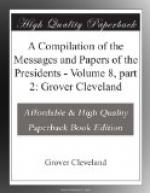The want of a true highland or mountainous character in this region is obvious from the aspect it presents in the two different points of view. Mountainous regions are most imposing when seen from a distance and from heights. On a nearer approach, and from the valleys which intersect them, the elevations, so important in the distant view, are hidden by their own slopes or lose the appearance of relative elevation in consequence of the absolute heights of the valleys themselves. In conformity with this character, the line claimed by the United States for the most part presents, when seen at a distance, the appearance of lofty and deeply serrated ridges, while to one who traverses it it is a labyrinth of lakes, morasses, and short but steep elevations which hide its peaks from the valleys and streams.
The line claimed by Great Britain, on the other hand, when seen from a distance is as level as the surface of the ocean, with no greater appearance of elevation and depression than would represent its billows; while, seen from its own valleys, the heights assume an importance which their elevation above the valleys when actually measured does not warrant. The characteristics of the region through which the line of Messrs. Mudge and Featherstonhaugh passes are therefore the opposite of those usually remarked in highland countries, while those of the line claimed by the United States are the same as are always observed in such regions.
This character of a table-land deeply cut by streams is well exhibited in the section of their “axis of maximum elevation” by the British commissioners. In that will be seen the mountains near the source of the Aroostook, Alleguash, and Penobscot on the one hand, and of the Tobique on the other, while the intervening space is occupied by a curve resembling an inverted arch, of which the St. John occupies the keystone. In a country of this character any line whatever would present the appearance of a succession of eminences, and might by as liberal a construction of the term as has been made by Messrs. Mudge and Featherstonhaugh be called highlands.
The sameness of this general character is broken only by a single chain of hills.[32] This is a prolongation of Mars Hill toward the north, and, being both of less height and breadth than that mountain, is hidden by it from the view of a spectator on Parks Hill. Mars Hill is itself an isolated eminence, and is in fact nearly an island, for the Presque Isle and Gissiguit rivers, running the one to the north and the other to the south of it, have branches which take their rise in the same swamp on its northwestern side. To the north of the Des Chutes the ground again rises, and although cut by several streams, and particularly by the Aroostook, the chain is prolonged by isolated eminences as far as the White Rapids, below the Grand Falls of the St. John, where it crosses that river. It may thence be traced in a northern direction to the Sugar Loaf Mountain, on the Wagansis portage, where it terminates.




